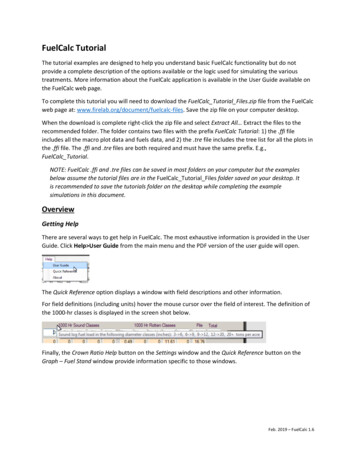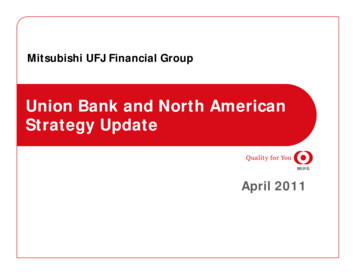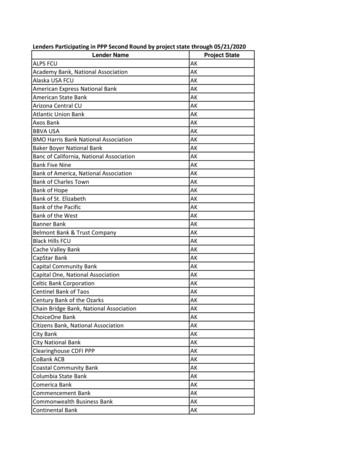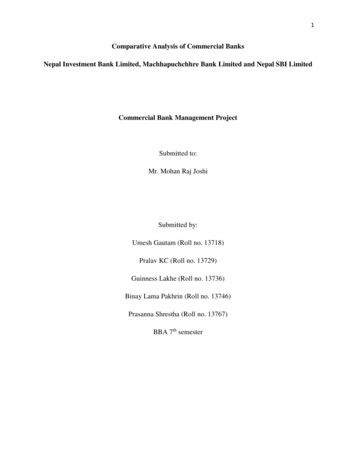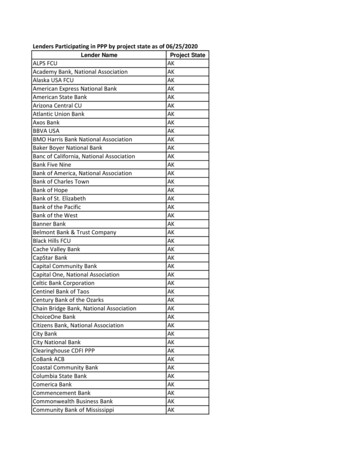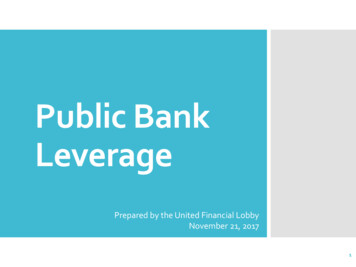
Transcription
Public BankLeveragePrepared by the United Financial LobbyNovember 21, 20171
What isleverage?“Leverage is the investmentstrategy of using borrowed money:specifically, the use of variousfinancial instruments or borrowedcapital to increase the potentialreturn of an /leverage.asp#ixzz4ytYGDcA72
Leverage inthe ConsumerContext A homeowner is able to use 25,000 incash to make a down payment topurchase a 250,000 home, obtaining amortgage to cover the remaining 225,000. The homeowner has “leveraged” her 25,000 in capital into a 250,000 asset. The homeowner’s equity ( 25,000) is10% of the asset value: a 10% leverageratio.3
Leverage inthe BankingContext Banks use borrowed funds to financeincome-generating bank assets (i.e.loans) If a bank is required to have a minimumcapital ratio (leverage) of 10%, it can use 500 million of capital to sustain assetsof 5 billion.4
Where do banks borrow their funds? Debt issuance (i.e. bonds)Leverage inthe BankingContext FRB, FHLB, or other lender to banks Generally for short term liquidityneeds Deposits5
A deposit is a form of loan from thedepositor to the bank.BanksBorrow byTakingDeposits“. . . drawers [depositors] have no moneyin banks. Only bankers have money inbanks. Drawers have choices in action[claims] against banks.”W.B. Farms v. Fremont Nat. Bank, 756 F.2d663 (8th Cir. 1985)6
Deposits arethe LargestSourceof BankFundingUS commercial banks week ending11/8/17* 16.7 trillion total assets 9.5 trillion loans 3.4 trillion investments 2.4 trillion cash (and deposits) 14.9 trillion total liabilities 12.0 trillion deposits 1.8 trillion equity* Source: FRB Statistical Release H.8 11/17/18 (notseasonally adjusted)7
A bank subject to a 10% capitalrequirement could hold assets (includingloans) of up to nine times its capitalLeverage inPublicBanking Example: 500 million capital investment 4.5 billion deposits 5.0 billion total assets (includingcash, fixed assets, investments, andloans)8
Leverage inPublicBanking Note that allowances must be made for: Liquidity (cash and short terminvestments and borrowingcapacity) Fixed assets and infrastructure (i.e.data processing system, lease orownership, etc.) Thus, assuming 90% loan/deposit ratio,loans are roughly 81% of assets;maintaining borrowing/liquidity capacitycould further reduce that amount9
As a long term source of funding, retaildeposits are cheaper than borrowing inthe capital market or wholesale fundingfrom preferred short term lenders such asthe FRB or FHLBWhyDeposits? Banks prefer deposits as the averageretail jumbo CD rate is approximately 150basis points lower than FHLB publishedrates reflecting the wholesale cost offund for similar terms:TermJumbo CDFHLB Advance RatesDifference (CD - FHLB)1 month 3 month 6 7-1.562.06-1.592.17-1.552.3-1.572.41-1.51Source: FDIC Weekly National Rates and Rate Caps and FHLB Des Moines website10
Public funds?Where Dothe DepositsCome From? Public funds deposits currentlycollateralized at 50% - 100% and subjectto pooled risk (all public depositoriespotentially liable for public funds lossesin other depositories) Depositories with lower than 100%collateral accept higher liability limitfor losses in other depositories11
If public bank is subject to collateralrequirements, the benefit of leverage isreduced or eliminatedCollateralizedPublic FundsDeposits inPublic BankExample: 500M capital; 4.5B public fundsdeposits 100% collateral requires 4.5Binvestment in permissible collateral;thus no loans 50% collateral requires 2.25Binvestment in permissible collateral;thus less than 2.25B loans, andpotential liability for otherinstitutions12
CollateralizedPublic FundsDeposits inPublic Bank Alternate source of collateral: FHLBletter of credit?* FHLB (or any other lender) requirescollateral for letter of credit FHLB requirements includeobligation to support housingthrough home mortgage lending orinvestment in mortgage securities Result: collateral still required;pledged to different party*Suggested in testimony at prior task force meeting13
UncollateralizedPublic FundsDeposits inPublic Bank Leverage benefit retained, but: Requires change in public funds law No collateral; public funds subject tocredit and operational risk of publicbank No risk spreading; risk of loss inpublic bank is borne solely by publicfunds depositors To the extent public funds are pulledfrom existing depositories, theymove from pooled (spread) risk toconcentrated risk that is unsecured14
Public FundsDeposits inPublic Bank Many public funds depositors requireservices beyond simple deposits: Payment processing (i.e. utilitydistricts) Treasury management services Merchant services15
Public BankDepositsFrom OtherSources FDIC insurance? Adds depositor confidence andsafety Increases cost, regulatory burden Reduces leverage benefit Uninsured? Risk to public Either requires additional marketing,compliance, and operations costs, otherhidden savings16
Asset/LiabilityManagementIssues in PublicBank Deposits Deposits are short term; most municipalloans are longer term S&L crisis redux? Liquidity financing (FHLB, etc.)requires liquid assets, collateral,etc., and is at higher rates than otherdeposits, affects profitability17
Contact Trent M. House (360) 888-397518
the FRB or FHLB Banks prefer deposits as the average retail jumbo CD rate is approximately 150 basis points lower than FHLB published rates reflecting the wholesale cost of fund for similar terms: 10 Term 1 month 3 month 6 month 12 month 24 month 36 month 48 month 60 month Jumbo CD 0.08 0.12 0.18 0.31 0.47 0.62 0.73 0.9




